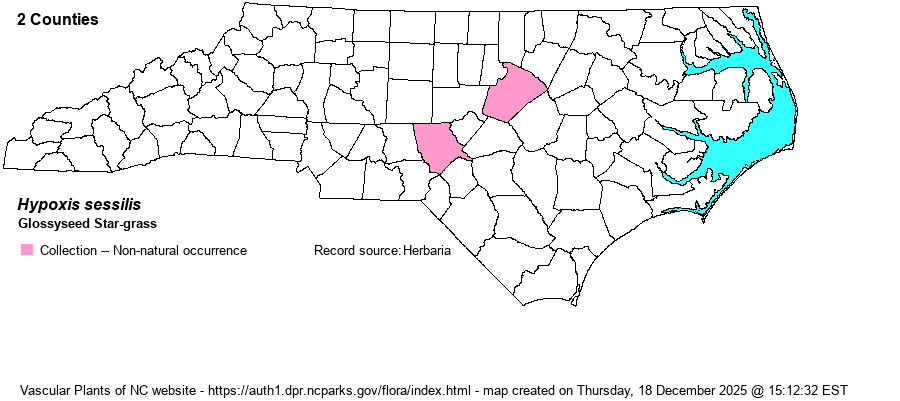| Author | L. | |
| Distribution | In September 2022 one of the taxon editors (Sorrie) reviewed all NC records and specimens. He concluded that NONE of them represent valid, natural occurrences, and that nearly all are misidentified. The only specimens that are correctly identified are those that were found adventive to Sorrie's own yard (place of origin unknown, ID verified by fruit characters) in Moore County. As briefly as possible, here are the salient details by county: Brunswick - Kim 289 (NCU), annotated to "?sessilis" by Herndon. ID is wrightii [=micrantha]. Brunswick - CVS plot Green Swamp Preserve, no specimens found fide Peet 2022. Columbus - Bell 11451 (NCU), annotated to "?sessilis" by Herndon. ID is wrightii. Columbus - burnt savanna, Kim 184 (NCU), annotated to "?sessilis" by Herndon. ID is wrightii. Dare - Crutchfield 2954 (NCU), annotated to "?sessilis" by Herndon. ID is wrightii. Gates - Ahles 40306 (NCU), broad leaves and marsh habitat point to curtissii. Hoke - 2 CVS plots on Ft. Bragg, no specimens found by Peet. Johnston - Radford & Stewart 147 (NCU), ID is wrightii. Pender - Leonard & Davis 7483 (NCU), ID is wrightii. Pender - Shaken Creek Savanna, 4 sheets by Thornhill at NCSC, 3 of them definitely are rigida and the fourth is inconclusive (no basal part). Robeson - Ahles 23767 (NCU), annotated to "?sessilis" by Herndon. ID is wrightii. Robeson - Britt 195 (NCU), ID is wrightii. Robeson - CVS plot, no specimens found by Peet. In 2024, a specimen was collected in Wake County (NCU).
This poorly known species, ranges north (reportedly) to the southeastern corner of VA (ID?; historical now), and south to southern FL, and west to eastern TX. If NC and VA records are not valid, then its range extends northward only to eastern SC (if correctly identified there). | |
| Abundance | The above data indicate that sessilis does not occur in NC as a native plant, but only as a very rare adventive/escape. In fall 2022, the NCNHP moved the State Status to Watch List (W3) as uncertain natural documentation, with a State Rank of SU (Undetermined). The website editors feel that a rank of SE? (probably exotic) is better, with a suggested status of W4 (uncertain provenance). | |
| Habitat | This is a species of wet pine savannas. The VA record was from a wet swale behind dunes, but the ID is suspect. In the early 2000s, plants volunteered in the yard of Bruce Sorrie and have produced plants every year since. It is thought that seeds were transported from a prior visit to Camp Stewart in southeastern GA. | |
| Phenology | Blooms in April (and later after a fire), and fruits mainly in May and June. | |
| Identification | This is the most difficult of the six star-grasses (Hypoxis) to identify in the state, and most characters are defined by features requiring a hand lens and a ruler. It has a quite short flowering scape, which can be as short as 1 inch but can range to 3 inches tall, but leaves often grow to a foot or more tall. Thus, the plant looks tall as in H. hirsuta and H. curtissii, but produces only 1-2 flowers instead of 2-5 and the leaves are half as wide (or less). Other star-grasses have the flowers on short stalks, but their leaves are much less than a foot long. Most importantly, the seeds are iridescent (shiny), as opposed to dull in other species, though this character may be difficult to use as plants in fruit can be easily overlooked in the field. Refer to Weakley (2018) for additional characters. Unlike with H. rigida, this species and H. juncea can be seen occasionally on a walk through a well-managed savanna near the southern coast. However, this is another star-grass that likely will have to be studied at very close range, with a hand lens, to be sure of the identification (at least without the use of the seeds, which are normally the clinching feature.) | |
| Taxonomic Comments | The taxon named as H. longii by some references is very close to H. sessilis and might be better treated as just H. sessilis. Most references do not recognize that putative species; however, H. sessilis is a long known and valid species, even though to this day it is still very poorly known in range and abundance.
| |
| Other Common Name(s) | Glossyseed Yellow Star-grass | |
| State Rank | SU [SE?] | |
| Global Rank | G3 | |
| State Status | W3 [W4] | |
| US Status | | |
| USACE-agcp | FAC link |
| USACE-emp | FACU link |

